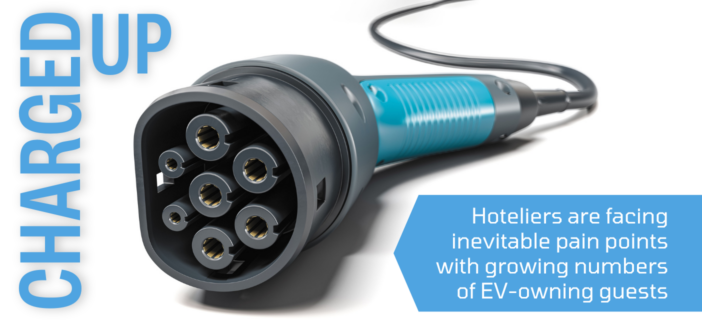Hoteliers are facing inevitable pain points with growing numbers of EV-owning guests
Almost 15 years ago, as newly elected President of the United States of America, Barack Obama ushered in eight years of policy changes and resulting legislation that were foundational to his party’s announced commitment to reduce the nation’s dependence on fossil fuels and a focus on developing and incentivizing alternative energy sources – one of the goals being to dramatically reduce CO2 emissions. To no great surprise, this came with an avowed decision that the internal combustion engine had to be phased out along with its need to consume gasoline and diesel to be replaced with electrically powered vehicles.
With the proliferation of electric vehicles on the market, consumer interest in on-the-road battery-charging stations is higher than ever. By 2018, doubtless motivated by the $7,500 federal tax credit on the purchase of a qualifying EV and a broader range makes and models, the EV ownership population had reached 2.1%.
Several years prior, the writing was clearly on the wall that the need for charging stations would only increase exponentially. Apart from TESLA drivers, who could use the company’s ever-expanding network of SuperChargers, 90% of other EV brands had much smaller capacity battery systems incapable of receiving the massive output of a SuperCharger.
As early as 2014 the level-2 EV charger came to market at a fraction of the cost of a DC-powered SuperCharger and requiring a 220/240-volt AC supply with a dedicated 40-amp circuit connection. Cost of a weatherized and pedestal-mounted level-2 charger equipped with a cashless credit/debit card reader and a WiFi or ethernet connection to a payment-processing platform for approximately $3,500 – plus the cost of sitework, electrical engineering, and installation. Those costs easily double or triple the purchase price of the charger.
A number of four- and five-star hotels and independent luxury boutique properties figured that while the number of EVs on the road was still small, projected growth justified the investment – especially in California, where EV ownership was well ahead of national rates. Their marketing and sales executives were less focused on EV-station revenue – instead emphasizing the investment as an amenity designed to attract EV-diving guests who could conveniently recharge their batteries overnight. A six-hour overnight charge would provide a range of 180-miles.
In retrospect, many flawed decisions were made, not the least of which was a failure to extend subsurface wiring conduit and stub-outs to accommodate the installation of additional EV chargers as demand grew beyond the capacity of the initial two or three chargers. Neither was there any anticipation of future advances in EV-charging technology.
Most of those ownerships took advantage of the then-available 30% federal tax credit of up to $30,000 that could be claimed on the total cost of each completed project, equipment, soft costs, and cost of installation.
THE HERE AND NOW
Fast forward to 2023. There are now close to one million DMV-registered, battery-operated vehicles on the roads, and the introduction of a broad range of models from compact, mid-size and luxury sedans, crossovers, SUVs, and trucks has led to prices from the low $40,000s to well beyond $100,000.
It also has led to the federal recognition that there has to be a massive incense in the number of EV-charging stations, both privately provided as an amenity for guests, residents, visitors, employees, etc., and on a public-access basis either as a standalone station or installed by a C-store, or at shopping centers, municipalities, etc.
Along with that, the federal tax rebate while remaining at 30% of total project cost has the cap increased up to $100,000 per completed and qualifying project. The baseline credit amount is 6% of the cost of a minimally qualifying project.
Recent print and broadcast media reports have highlighted numerous complaints from EV drivers who have booked accommodation at a hotel that offers EV charging as an amenity. Complaints are real and have a negative impact on a guest’s relationship with the hotel, its management, and the brand.
Common guest complaints:
How well-trained are your front desk staff and management employees in handling and de-escalating guest frustrations, which can get loud and confrontational? There’s no magic pill to cure these types of complaints.
However, some suggestions:
- Your website needs to include your policy regarding guest access to and use of EV chargers, even if it’s as basic as “subject to availability.”
- When receiving a phone reservation, ask if the guest will be driving an EV and briefly explain use policy.
- Provide a copy of your EV-use policy to every EV driving guest at time of check-in.
- Maintain a list of local publicly accessible EV-charging stations to inform guests of possible options.
- If you have an EV guest who booked a specific time to start and end their charging cycle and they haven’t moved their vehicle away from the station, call their cellphone and courteously advise that another guest needs to use the charger.
The reality is the above issues will only multiply in frequency as EV ownership continues to increase. While adding level-2 EV chargers may appear to be budget friendly, at a mere 30 miles of added range per hour they aren’t an appropriate solution for today or for tomorrow. Your focus needs to be on a level-3 fast charger, which can add anywhere from 35 to 130 miles of range in 15-minutes depending on the size and power output of the charger.
The properties with a level-3 charger will quickly earn a reputation as a must-stop destination for travelers looking for a bit of juice to make it to their destination.





